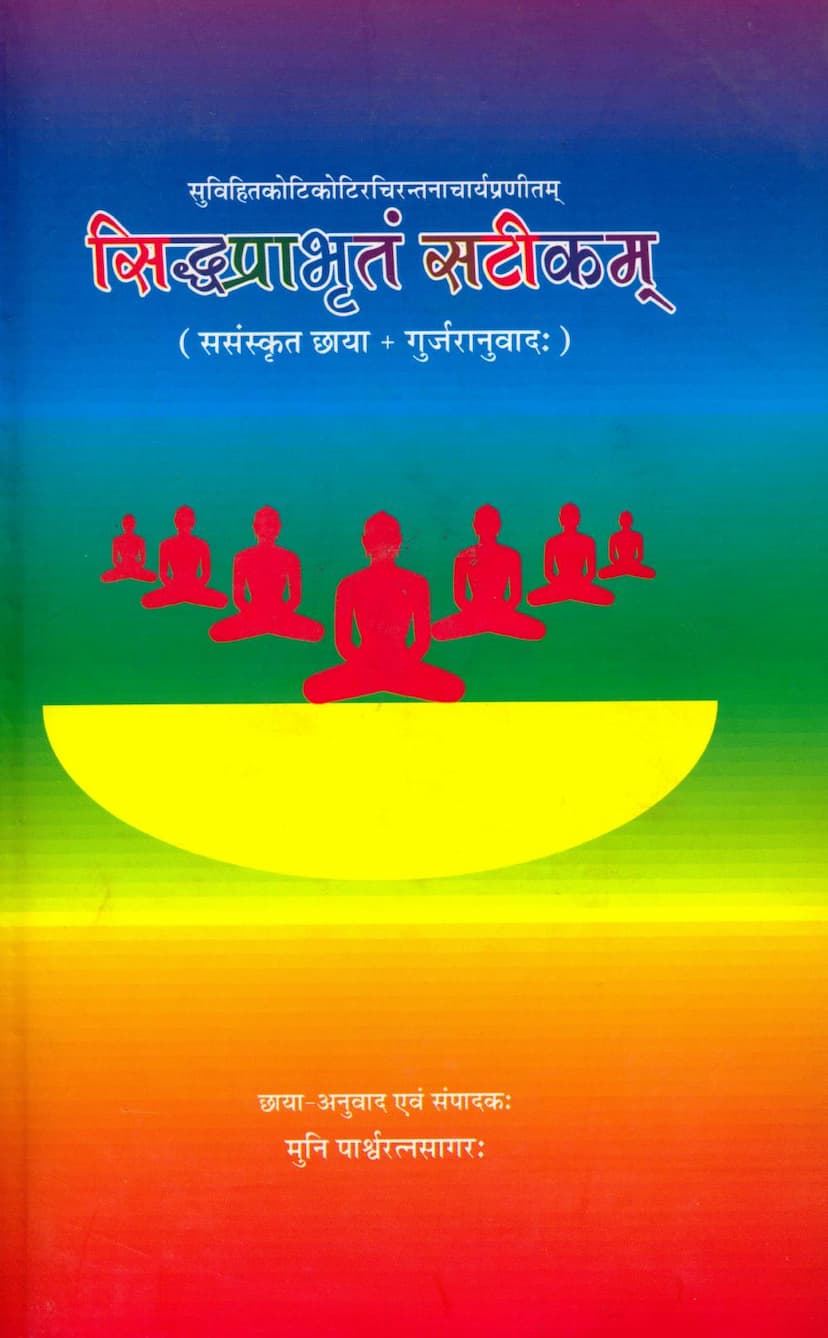Siddha Prabhrutam Satikam
Added to library: September 2, 2025

Summary
Here's a comprehensive summary of the Jain text "Siddha Prabhrutam Satikam," authored by Parshwaratnasagar and published by Omkarsuri Jain Gyanmandir, based on the provided pages:
Overview:
"Siddha Prabhrutam Satikam" is a commentary on the ancient Jain text "Siddha Prabhrutam." The original "Siddha Prabhrutam" is an extracted chapter from the second Pūrva titled "Āgraṇīya" within the 14 Pūrvas of the Dṛṣṭivāda Anga of Jain scripture. The book presents the original text with a Sanskrit commentary (Chāyā) and a detailed Gujarati translation, making this profound scripture accessible to a wider audience. The commentary and translation have been meticulously done by Muni Pārśvaratnasāgara.
Key Content and Structure:
The book is a scholarly work that aims to elucidate the nature and attributes of the Siddhas (liberated souls) according to Jain philosophy. It follows a structured approach, typical of classical Indian religious texts, which includes:
-
Mangalācaraṇa (Invocation): The text begins with auspicious invocations, paying respects to the omniscient Jinas (Tirthankaras) and the spiritual guides (Gurus). This section lays the foundation for the scriptural exposition, establishing the lineage of knowledge and the sacredness of the undertaking. The first chapter (Gāthā 1-3) outlines the mangala (auspiciousness), the connection with the lineage of Gurus, and introduces the subject matter.
-
Abhidheya (Subject Matter): The primary subject is the "Vyakhyāna" (discourse) on the Siddhas, which is established through various means like Nīkṣepa (classification), Nirukti (etymology), and Anu-yoga Dvāras (analytical sections). The book details the various classifications and descriptions of Siddhas as expounded in the scriptures.
-
Nīkṣepa and Nirukti: The text delves into the definitions and classifications of Siddhas. It explains the different categories of Siddhas, such as Dravya Siddha (substantive Siddhas) and Bhāva Siddha (essential Siddhas), and further elaborates on their meanings through etymological analysis.
-
Anu-yoga Dvāras (Analytical Sections): A significant portion of the book is dedicated to analyzing the Siddhas through various Anu-yoga Dvāras. These sections systematically examine the Siddhas based on:
- Kṣetra (Space): The locations where Siddhas reside (e.g., the Siddhaśīlā at the apex of the universe).
- Kāla (Time): The temporal aspects related to Siddhas, including the cycles of time (Avaparpīṇī, Utsarpiṇī) and their presence throughout eternity.
- Gati (States of Existence): The journey of souls from different states of existence (hellish, Tiryanch, human, divine) to the state of liberation.
- Veda (Sensual Dispositions): The absence of sensual dispositions (Veda) in Siddhas.
- Tīrtha (Religious Order/Abode): The Siddhas' association with or separation from Tīrthas (places of religious significance or orders).
- Liṅga (Attributes/Forms): The Siddhas' state of being free from any form or attribute that binds to the cycle of birth and death.
- Cāritra (Conduct): The perfect and pure conduct of the Siddhas, free from any impurities.
- Buddhi (Knowledge/Consciousness): The nature of the Siddhas' unerring and omniscient consciousness.
- Jñāna (Knowledge): The absolute and perfect knowledge of the Siddhas.
- Avagāhana (Dimension/Extent): The extent or dimension of the Siddhas' souls in the liberated state.
- Utkṛṣṭa (Supreme/Excellent): Aspects related to the supreme state of the Siddhas.
- Antara (Interval): The intervals of time or existence between the manifestation of Siddhas.
- Gaṇanā (Counting/Quantity): The numerical aspects and counts related to Siddhas.
- Alpabahutva (Fewness/Multiplicity): The comparative numbers of Siddhas in different contexts.
- Sannikarṣa (Conjunction/Proximity): The detailed analysis of how Siddhas manifest and their relative numbers across various parameters.
-
Nayas (Viewpoints): The text emphasizes the importance of different Nayas (viewpoints) like Niścaya (Absolute) and Vyavahāra (Conventional) in understanding the nature of Siddhas. It explains how different philosophical schools might perceive the Siddhas and how Jain philosophy resolves these perspectives.
-
Historical Context and Sources: The preface and introductory sections highlight that the original "Siddha Prabhrutam" is derived from ancient Pūrvas. The commentary mentions that the text was edited based on five manuscripts, including palm-leaf manuscripts. It also acknowledges the efforts of previous editors and scholars, referencing works like "Abhidhān Rājendra Koś" and the writings of prominent Jain scholars.
-
Commentary (Tīkā) and Translation: The book includes a Sanskrit commentary (Chāyā) which explains the original Prakrit verses, and a Gujarati translation that further simplifies the concepts for the readers. The translator and commentator, Muni Pārśvaratnasāgara, has aimed for clarity and comprehensibility.
-
Appendices (Parishishta): The book includes appendices such as "Shri Mad Devendrasuri Kruta Siddha Pañcāśikā" and "Shri Siddha Daṇḍikā Stavaḥ." These are additional texts that complement the study of Siddhas, offering further insights into their nature and qualities. "Siddha Pañcāśikā" by Devendrasuri is a concise exposition on Siddhas, and "Siddha Daṇḍikā Stavaḥ" is a devotional hymn in praise of Siddhas.
Significance and Purpose:
- Understanding Siddhahood: The primary goal of the book is to provide a deep and systematic understanding of the state of liberation (Siddhahood) in Jainism.
- Accessibility: By providing a Sanskrit commentary and a Gujarati translation, the work makes a complex and ancient text accessible to contemporary readers and scholars.
- Scholarly Contribution: The book represents a significant contribution to Jain literature by preserving and illuminating an important Pūrva-derived text, ensuring its study and appreciation.
- Spiritual Upliftment: The ultimate aim is to inspire readers towards the path of liberation by understanding the virtues and state of the Siddhas, thereby encouraging self-improvement and spiritual practice.
Authorship and Publication:
- Author of Commentary/Translation: Muni Pārśvaratnasāgara.
- Publisher: Shri Omkarsuri Jain Gyanmandir, Gopipura, Surat.
- Edition: First Edition, published in Vikram Samvat 2069 (2012 CE).
- Previous Editions/Editions: Mentions prior compilations and re-printings by other trusts, highlighting the continued relevance and study of the text.
In essence, "Siddha Prabhrutam Satikam" is a comprehensive and scholarly presentation of the Jain doctrine concerning liberated souls, offering a detailed, annotated, and translated exposition of a vital ancient Jain scripture.